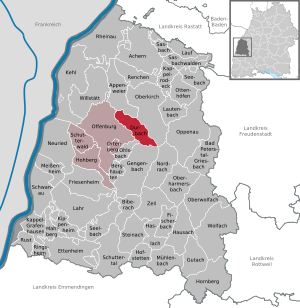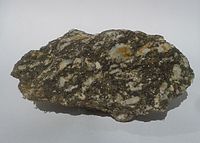Durbach
| coat of arms | Germany map | |
|---|---|---|

|
Coordinates: 48 ° 30 ' N , 8 ° 1' E |
|
| Basic data | ||
| State : | Baden-Württemberg | |
| Administrative region : | Freiburg | |
| County : | Ortenau district | |
| Height : | 208 m above sea level NHN | |
| Area : | 26.33 km 2 | |
| Residents: | 3893 (Dec. 31, 2018) | |
| Population density : | 148 inhabitants per km 2 | |
| Postal code : | 77770 | |
| Area code : | 0781 | |
| License plate : | OG, BH , KEL, LR, WOL | |
| Community key : | 08 3 17 021 | |
| Address of the municipal administration: |
Tal 5 77770 Durbach |
|
| Website : | ||
| Mayor : | Andreas King | |
| Location of the municipality of Durbach in the Ortenau district | ||
Durbach is a municipality in the Ortenaukreis in Baden-Wuerttemberg ( Germany ).
geography
Geographical location
The wine and recreation area of Durbach, with an area of 2633 hectares on the Baden Wine Road, is located in the foothills between the Rhine plain and the Black Forest , about seven kilometers from the district town of Offenburg . Embedded in vineyards and a total of 42 side valleys, Durbach extends along the stream of the same name.
Community structure
The community is divided into the district of Durbach with 2664 inhabitants and the district of Ebersweier (1243 inhabitants), which was incorporated in 1973 as part of the regional reform . The municipality of Durbach includes 47 villages, hamlets, Zinken, farms and houses.
In the municipality of Durbach are the abandoned villages Buchenbronn, Starzengrund and Stollenweier.
Neighboring communities
The municipality borders Appenweier in the north, the city of Oberkirch in the east, the city of Gengenbach and Ohlsbach in the south and the district town of Offenburg in the west .
history
20th century
Durbach used to be part of the Offenburg district , which was incorporated into the new Ortenau district in 1973. On January 1, 1973, the previously independent municipality Ebersweier was incorporated.
Population development
Population figures according to the respective area. The numbers are estimates, census results or official updates from the Baden-Württemberg State Statistical Office .
|
|
* 1975 and 1980 as well as from 1990 as of December 31st
politics
Municipal council
The local elections on May 26, 2019 led to the following result with a turnout of 68.2% (+ 3.8% p):
| Party / list | Share of votes | +/-% p | Seats | +/- |
| Christian Democratic Union of Germany (CDU) | 44.6% | - 3.1 | 5 | - 2nd |
| Free Voter Association (FWV) | 55.4% | + 3.1 | 7th | ± 0 |
Compared to the result of the previous election with 14 members, the municipal council now only has twelve members.
mayor
- 1939–1945: Josef Anton Huber
- 1945–1946: Josef Singler
- 1946–1948: Franz Xaver Müller
- 1948–1969: Andreas Glanzmann
- 1969–1993: Hans Weiner
- 1993-2001: Wolfgang Pühler
- 2001-2014: Toni Vetrano
- 2014 until today: Andreas König
coat of arms
Blasonierung : "In silver on blue Dreienberg a red cup sullied with two pole have red sharp cornered covers ( patens ), the upper larger."
The shape and form of the Durbach coat of arms is taken from that of the former "House of Staufenberg" ("In silver on a blue three-mountain, a red goblet, raised by two pillar-like red, pointed lids, the upper one larger. On the silver helmet (on a leaning shield) with red -silver blankets a growing, silver-clad human stump with two buffalo horns, inside the shield elements. "). The oldest surviving form of the seal, that of the Cunradi de Stollenberg (1273), a Staufenberg family, contains the "Stauf", a goblet or goblet. "Stauf" and "Berg" form the name "Staufenberg" as a " talking coat of arms ". In ancient times, a mountain with steep slopes was also referred to as a Stauf, corresponding to an inverted chalice. The lids were made from rings around the goblet, which then took the form of paten and finally floated over the goblet as a pointed lid.
Town twinning
Durbach maintains a city partnership with the following cities :
-
 Bürserberg , Vorarlberg , Austria
Bürserberg , Vorarlberg , Austria -
 Châteaubernard , Nouvelle-Aquitaine , France.
Châteaubernard , Nouvelle-Aquitaine , France.
administration
The municipality has agreed an administrative partnership with the city of Offenburg and the municipalities of Hohberg, Ortenberg and Schutterwald.
Culture and sights
The Kultur im Schloss event series includes readings by authors and concerts. The autumn festival at Staufenberg Castle (second weekend in October) is dedicated to a different topic every year. In 2006 the motto was 200 years of Baden . In 2007 the 225th birthday of the Klingelberger Riesling was celebrated. In 2020 it will be under the sign of "950 years of Staufenberg".
The Staufenburg Clinic also offers patients and visitors a cultural program with concerts and exhibitions.
Theaters and museums
- In 2002 and 2005, Staufenberg Castle was the setting for an open-air theater piece.
- The wine and local history museum is located in the center of the village.
- The Museum of Contemporary Art - Hurrle Collection in the building of the Hotel "Vier Jahreszeiten" has been closed since October 2019.
Sculpture park
To the south of the Staufenburg Clinic lies the extensive Durbach Sculpture Park with 73 works by international sculptors.
Economy and Infrastructure
The economic foundation of the community is based on viticulture / agriculture, tourism and specialist clinics. This structure is supplemented by around 100 commercial operations, most of which employ five to 15 people. There are two bakeries, two butchers, food retailers, hairdressers, electronics stores, doctors and a pharmacy in the village.
education
In Durbach there is a two-class elementary school with a primary school support class , the Staufenberg School . There is also a municipal, a church and a kindergarten that is privately owned. The communal kindergarten in Ebersweier and the Catholic kindergarten St. Heinrich in Durbach have meanwhile been expanded into a day-care center with a comprehensive range of childcare.
Agriculture and viticulture
The wine and fruit growing is one of the main sources of Durbacher. The documents belonging to the region Ortenau in the wine region Baden . Wine has been cultivated in Durbach since the 12th century (traceable to 1180). There are more than 80 full-time farmers and around 200 part-time winemakers in the Durbach wine cooperative. Together with the 12 private wineries, the Durbach wine cooperative is one of the most award-winning wine producers in Germany and Europe. Durbach is the wine town with the most private wineries in Baden-Württemberg. At the same time, Durbach is currently the only wine village in which all 12 wine producers offer their products in one place (Durbacher LÄDELE). The Graf Wolff Metternich winery is considered to be the oldest in Durbach and the Ortenau region. The Heinrich Männle and Andreas Laible wineries have been selected as one of the 20 best European wineries in the world since 2006. The Markgraf von Baden winery is a member of the Association of German Predicate and Quality Wineries . Durbach is the place in the world with the largest contiguous cultivation area for Savagnin Rose (Roter Traminer, also called Clevner in Ortenau ). This grape variety is still grown in Heiligenstein / Alsace (France), Visperterminen (Switzerland), Klöch (Austria) and Tramin / Termeno (Italy).
tourism
The Schloss Staufenberg estate is privately owned by Max Margrave von Baden. As a landmark, it towers high above Durbach. From the castle terrace on the 383 meter high mountain cone there is a panoramic view over forest-covered Black Forest peaks, vineyards, the village at your feet up to the Upper Rhine plain and the Strasbourg cathedral. Staufenberg Castle can be reached via hiking trails and a road.
rehabilitation
The Mediclin Staufenburg Clinic in Durbach is a specialist clinic for internal medicine specializing in diabetology, oncology / urology and rheumatology / orthopedics.
The clinic focuses on the treatment of metabolic diseases, in particular type 1 and type 2 diabetes, tumor diseases of the kidneys and urinary tract, and diseases of the musculoskeletal system.
Web links
- Durbach community
- Durbach and Staufenberg Castle on badischewanderungen.de
Individual evidence
- ↑ State Statistical Office Baden-Württemberg - Population by nationality and gender on December 31, 2018 (CSV file) ( help on this ).
- ^ The state of Baden-Württemberg. Official description by district and municipality. Volume VI: Freiburg region Kohlhammer, Stuttgart 1982, ISBN 3-17-007174-2 . Pp. 392-394
- ^ Federal Statistical Office (ed.): Historical municipality directory for the Federal Republic of Germany. Name, border and key number changes in municipalities, counties and administrative districts from May 27, 1970 to December 31, 1982 . W. Kohlhammer, Stuttgart / Mainz 1983, ISBN 3-17-003263-1 , p. 500 .
- ↑ Population development in Baden-Württemberg from 1871 to 2013 ( Memento from September 11, 2014 in the web archive archive.today )
- ^ State Statistical Office of Baden-Württemberg: Results of the 2019 municipal council elections - Durbach












